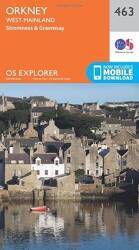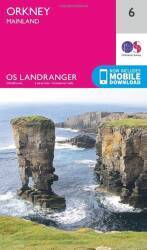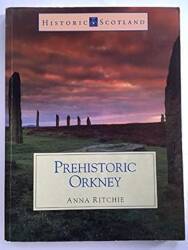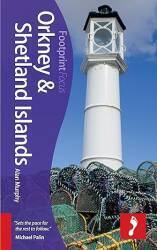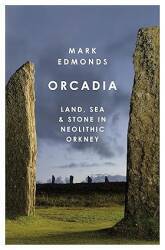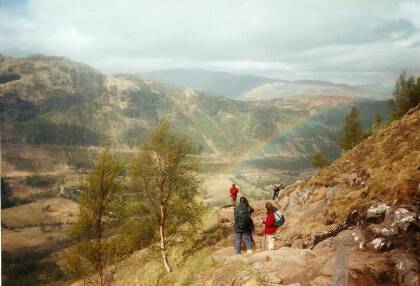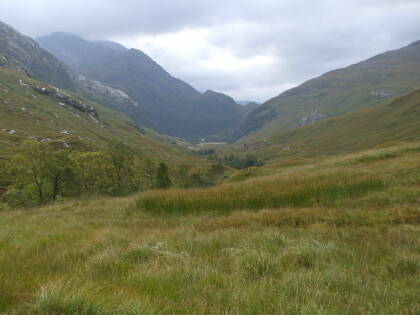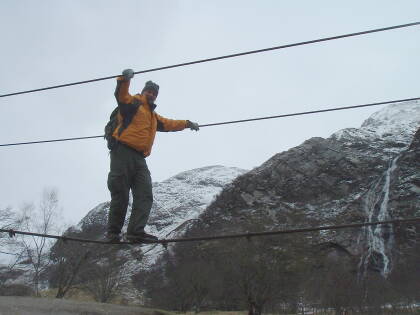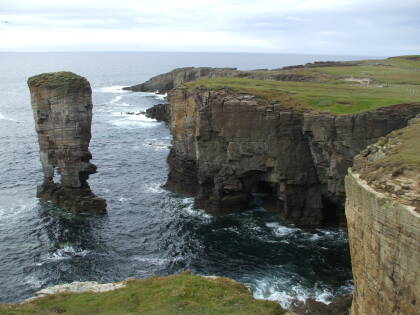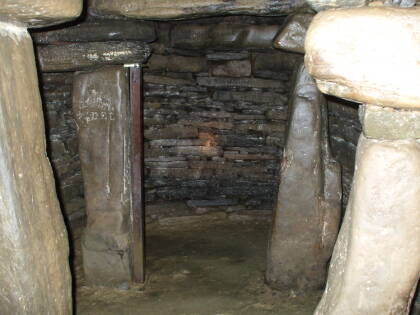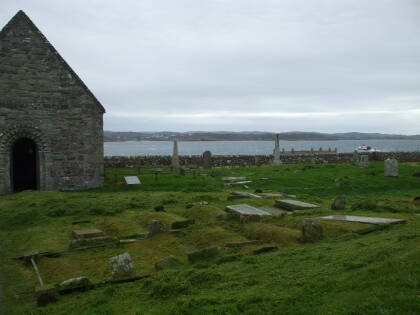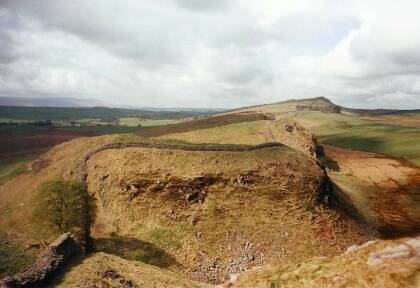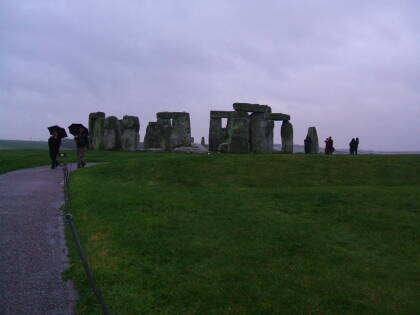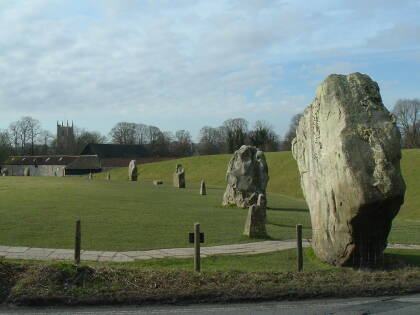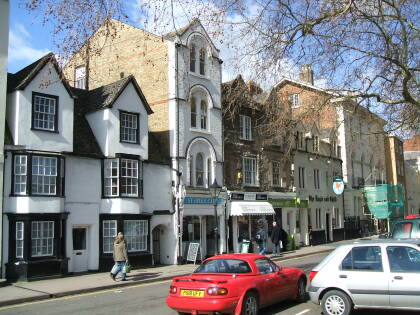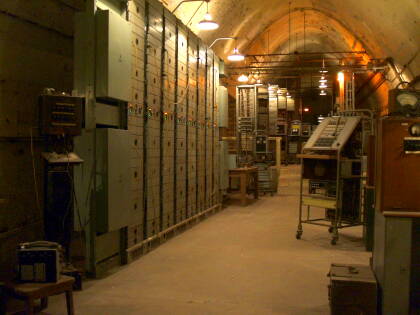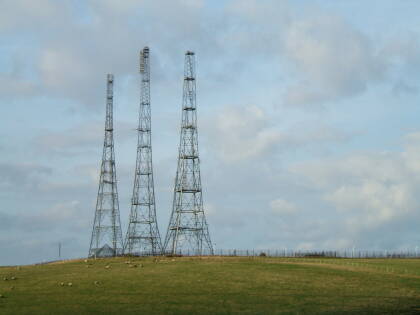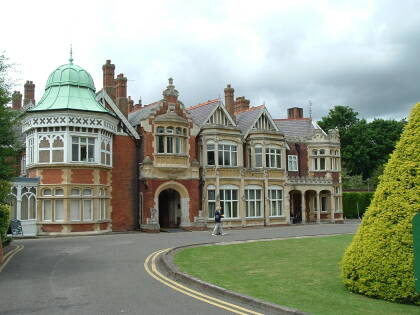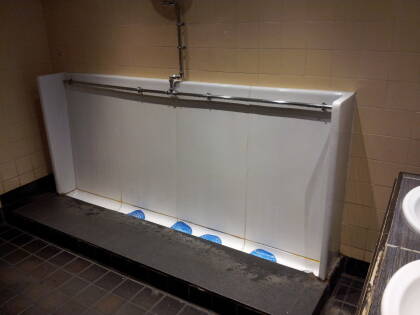
Neolithic Village at Skara Brae, Orkney
Skara Brae
Skara Brae is a large Neolithic settlement on the Bay of Skaill on the west coast of Mainland, the main island of the Orkney Islands, just off the north coast of Scotland. The settlement is a cluster of eight dwellings and it was occupied roughly 3100-2500 BC. It's Europe's most complete Neolithic village and it was discovered only in 1850. It was well preserved when it was discovered, and the early excavations were unusually careful for that time.
Let's see what there is at Skara Brae today.
Orkney is off the northern coast of Scotland. The largest island of the group is called Mainland, from the Old Norse name Meginland. You get there by taking a bus to Scrabster and Thurso, on Scotland's north coast. From there you a ferry to Stromness, the main passenger port in Orkney.
The settlement was built on, and into, a midden heap from a previous settlement. A midden heap is a mound of domestic refuse, or to put it bluntly, an old garbage dump. That material provided insulation against the harsh winter climate at that latitude.

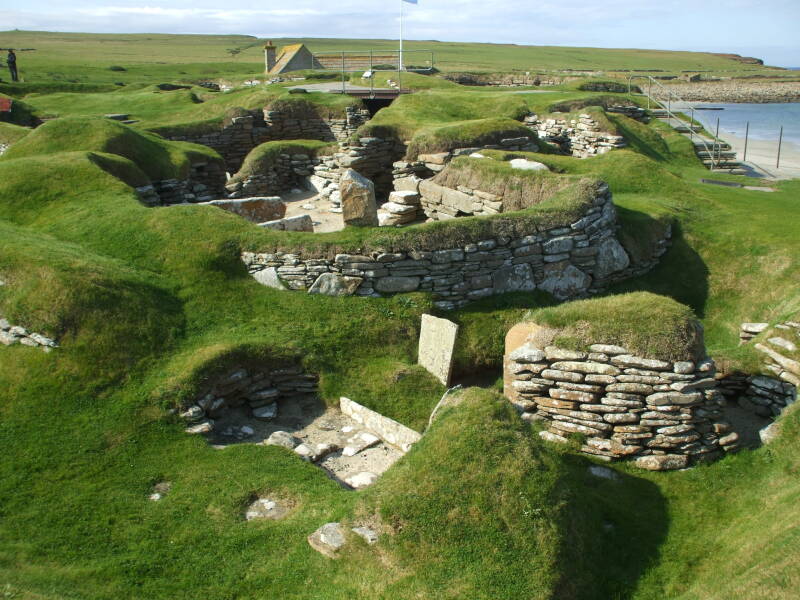
Archaeology often involves digging through the trash of long-dead people. Their refuse can provide a lot of information about their daily lives.
The structures at Skara Brae were connected with narrow curving passageways that were also covered to protect the entire settlement from the weather. The small size and curving paths of the passageways limited the wind blowing through the communal structure.
The walls and furniture are built from stone. The local sandstone splits into plates or sheets suiting it for certain types of construction. There were few trees on the Orkney Islands in the Neolithic era, and almost none today. They used driftwood and whalebone to form frames for the roofs. Some of the driftwood came from northeastern North America along the clockwise gyre of the north Atlantic.
Sheets of turf would have been laid over that framework with thatch on top, much like what has been used in the Highlands and the Outer Hebrides through the early 20th century.
Here is where the settlement fits into prehistoric and historic periods as those periods are commonly divided for Britain based on the cultural and technological developments there:
| Years | Era | Events |
| 2,500,000 – 10,000 BC | Paleolithic | Origin of man and development of stone tools. Homo sapians neanderthalensis appeared in Europe 600,000 to 350,000 years ago and disappeared by 30,000 BC. |
| 10,000 – 2100 BC | Neolithic |
Began about 10,000 BC with the development of
farming crops of einkorn wheat, millet and spelt,
and the keeping of dogs, sheep and goats.
Farming communities appeared at Jericho about
8500 BC and spread to Asia Minor,
North Africa and North Mesopotamia by 8000 BC.
Pottery arose in various forms. Jericho is often referred to as the first city, going back to about 10,000 BC. Çatalhöyük (now in Turkey) is another early large settlement, from 7500 BC. Agrarian societies appeared in southeastern Europe by about 7000 BC and central Europe by about 5500 BC. Skara Brae was occupied about 3100-2500 BC. |
| 2100 – 700 BC | Bronze Age |
Development of metals, specifically
bronze, an alloy of copper and tin.
The Neolithic-Bronze and Bronze-Iron boundaries (that is, the development of those two metal technologies) varies with location. |
| 700 BC – 450 AD | Iron Age |
Period when the main technology was based
on iron.
In Britain, considered to have lasted until the Roman conquest, at least as far as Hadrian's Wall, or until the mid-400s in Scotland. |
Each of the Skara Brae dwellings contained a number of stone furnishings. Seven of the structures were dwellings, following a common design. The eighth seems to have been a common work area for communal cooking and tool production.
Each dwelling was approximately square and about 40 square meters in size. The entryway was at the center of one side, out of sight at lower right in this picture.
A stone hearth was at the center of the dwelling, the darker stone surface at lower right. This would have been used for heating, light and cooking.
Opposite the entrance was a cabinet, a stone set of shelves and compartments. It would have been the first thing seen when entering the dwelling, and it is thought that this layout was intentional to display important possessions.
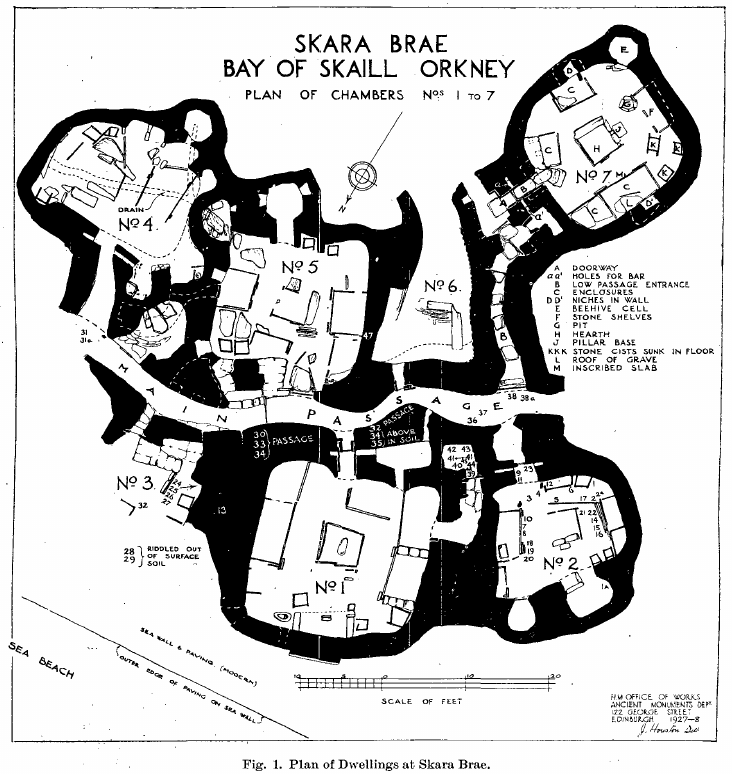
Plan of chambers 1–7 from Provisional Report on the Excavations at Skara Brae and on Finds from the 1927 and 1928 Campaigns, V. Gordon Childe and J. Wilson Paterson, Proceedings of the Society of Antiquaries of Scotland, February 11, 1929
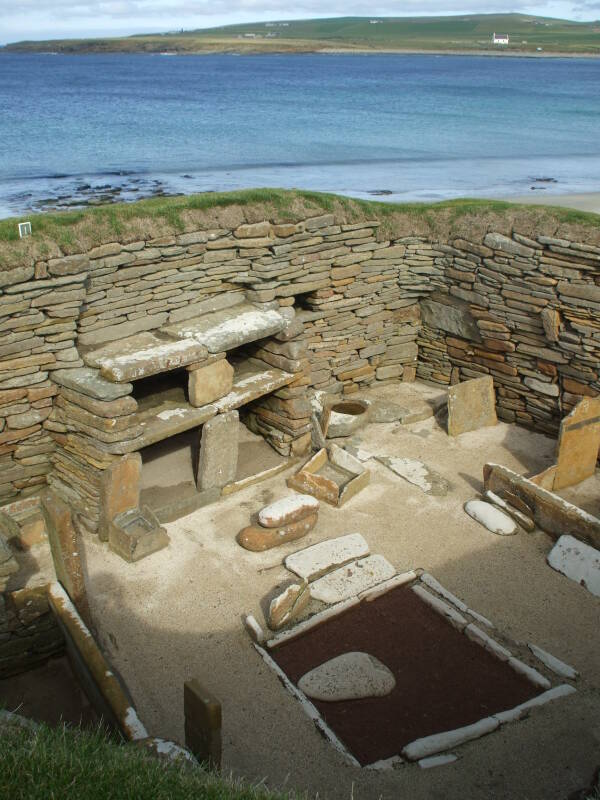

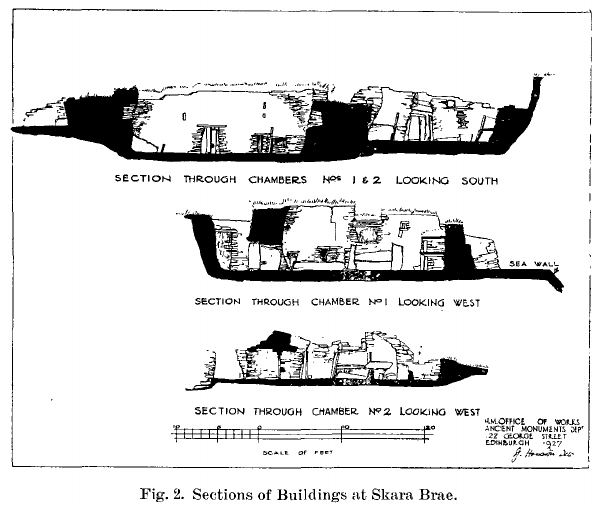
Sections through chambers 1 and 2, from Provisional Report on the Excavations at Skara Brae and on Finds from the 1927 and 1928 Campaigns, V. Gordon Childe and J. Wilson Paterson, Proceedings of the Society of Antiquaries of Scotland, February 11, 1929
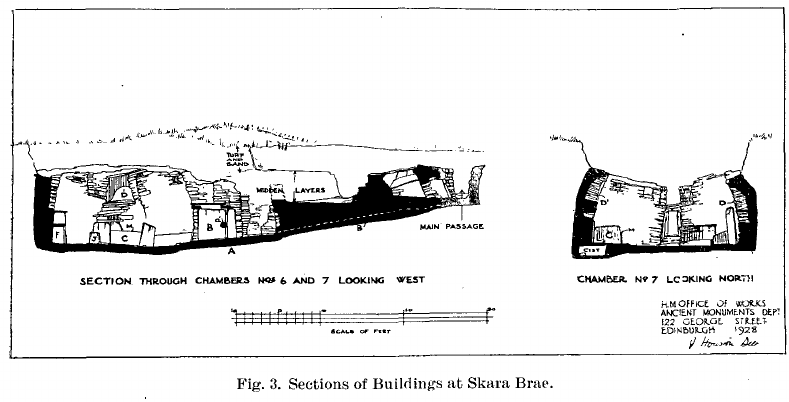
Sections through chambers 6 and 7, from Provisional Report on the Excavations at Skara Brae and on Finds from the 1927 and 1928 Campaigns, V. Gordon Childe and J. Wilson Paterson, Proceedings of the Society of Antiquaries of Scotland, February 11, 1929
How Modern Were The Dwellings?
The other front corner, on the opposite side of the cabinet from the bait boxes, is a small chamber referred to as a cell in the material in the museum and at the Skara Brae site itself. The floors of the cells are up to 40 cm above that of the main room. The cells are 100–110 cm high and 90–100 cm in diameter.
According to the explanatory material at the Skara Brae site, drainage systems have been discovered in some of the cells. According to their interpretation, the cells "may have been toilets."
Zooming in on the plan from the 1928 and 1929 expeditions, we see a branching train that links the cells in dwellings number 4 and 5 with the outside.

Dwelling 4 and part of dwelling 5, showing their small cells and a Y-shaped drain that joins them and the exterior, from Provisional Report on the Excavations at Skara Brae and on Finds from the 1927 and 1928 Campaigns, V. Gordon Childe and J. Wilson Paterson, Proceedings of the Society of Antiquaries of Scotland, February 11, 1929
Other interpretations are more definite. For example, Pillars of the Past, Volume Four, simply states that the cells were a primitive form of toilet.
Skara Brae was clearly not a large settlement and its people could easily have left their filth in the nearby fields to act as fertilizer. With a population estimated from between 50 to 80 people, they had to go out of their way to construct at great cost and effort a sewer system attached to what were apparently separate toilet rooms, thousands of years before such conveniences had become common in the first millennium cities and towns in the ancient world.
So, are the Skara Brae cells Neolithic era toilets?
Probably. Some people say that they are. Some say that they may be. No one seems to be saying that they definitely aren't, or offering any specific alternatives.
A 2020 paper reported that the Neolithic era coprolites at the site were from domestic dogs, who were probably eating the community's meal refuse, plus the local voles. It was all dog poop, not human.

The cell of this dwelling is at upper right in these views.
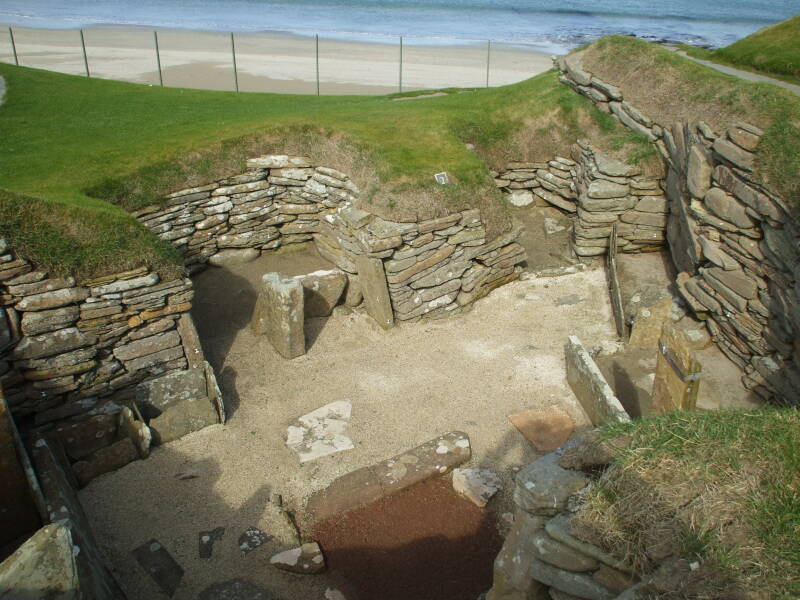
This dwelling is unusual in that it has a "secret compartment", a sizeable storage area behind its cabinet. This might have been used as a secret storage area, although it's hard to imagine a secret lasting very long in such a small and close community.
The best preserved dwelling, designated as House 7, has some very fine carvings that were starting to deteriorate as it was no longer protected by being buried in sand. British Heritage covered the house with a glass roof, but this made the deterioration worse instead of better.
They have replaced the glass roof with one of sod, maintaining a much more constant environment inside the house. This unfortunately means that you can't see it. To make up for this, they have built a precise replica that you can enter.
This shows the mounded exterior of the House 7 reconstruction. Driftwood and whale rib roof beams would have supported a roof of turf and thatch, and grass would have soon covered that.

As you enter the dwelling from the narrow passageway you look across the main chamber, across the hearth to the cabinet.
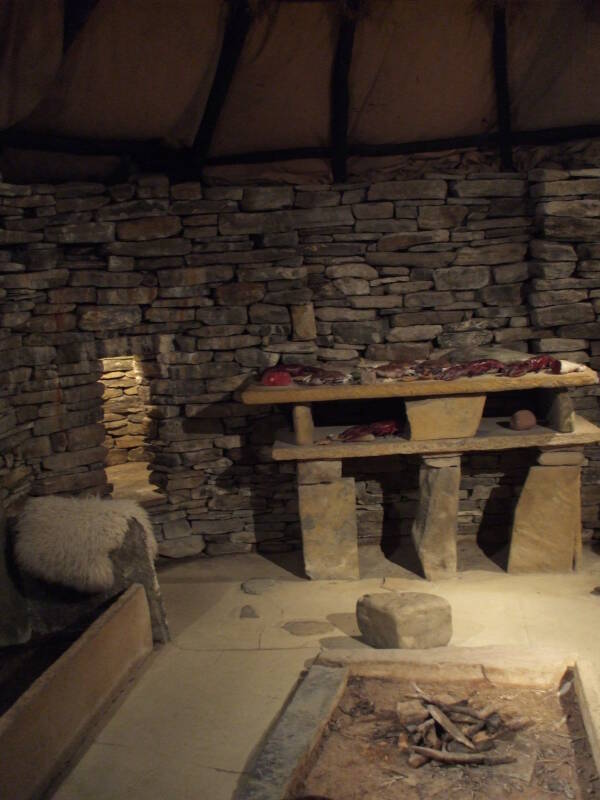
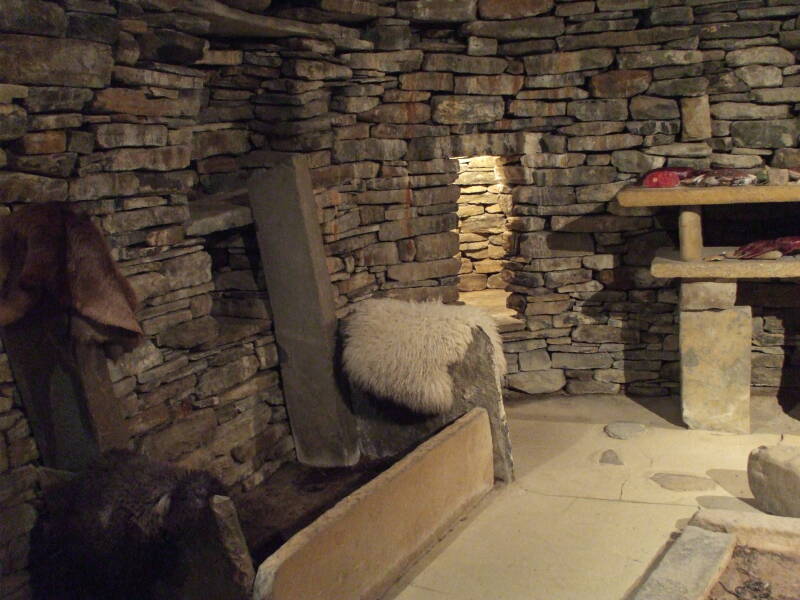
One set of bed boxes is along the left wall. The cell is in the far corner at the left of the cabinet.
Here it is, a view into the cell.

Logistics
Here is a map of the UK. The Orkney Islands are just off the northern coast of Scotland.
The National Museum of Scotland in Edinburgh has a large and well-done exhibit of items from prehistoric Scotland, including quite a bit from Skara Brae. The museum at Skara Brae itself is small and mostly explains the site — the artifacts are mostly in Edinburgh.
Almost certainly if you aren't British, and quite likely if you are, you will travel to Orkney by way of Edinburgh. See the National Museum's collection before going to Skara Brae, and see it again afterward when it will make more sense. Some of the collection is available online.

Transport to Orkney
Edinburgh to Inverness, 3 hours 30 minutes by bus, via Perth and Pitlochry, buses every 3 hours or so.
Inverness to Scrabster (adjacent to Thurso), 3 hours 45 minutes by bus, a few buses a day.
Scrabster to Stromness, 1 hour 30 minutes by ferry, a few ferries per day.
Once in Stromness, check the bus schedules at the Tourist Information Center at the ferry terminal. There are a few buses per day stopping at Skara Brae. After visiting Skara Brae and the adjacent Skaill House (home of the Laird who owned the land and discovered the site), you could return to Stromness via a later bus.
West Coast WalkA better alternative if you get an early enough start is to return to Stromness on foot along the West Coast Walk. It's about 17 kilometers along the tops of the rugged cliffs along the west coast of Mainland, the main island of Orkney.
A good place to stay is
Brown's Hostel,
just a couple of short blocks down the main Victoria Street
from the ferry terminal:
45-47 Victoria Street
Stromness, Orkney, KW16 3BS
+44-(0)1856-850-661
+44-(0)1856-851-780 fax
www.brownshostel.co.uk
